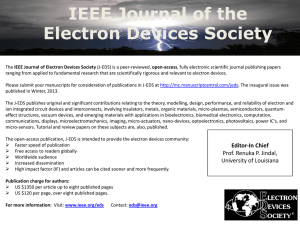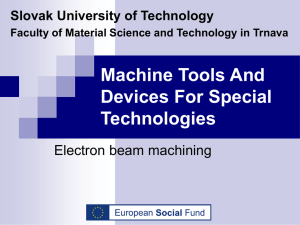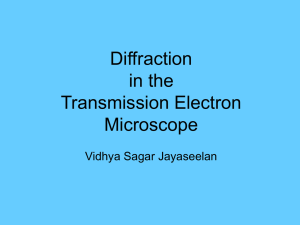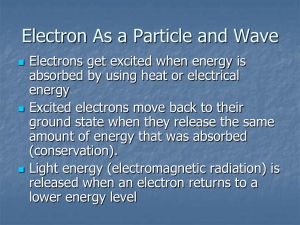Thieberger, Halo workshop
advertisement
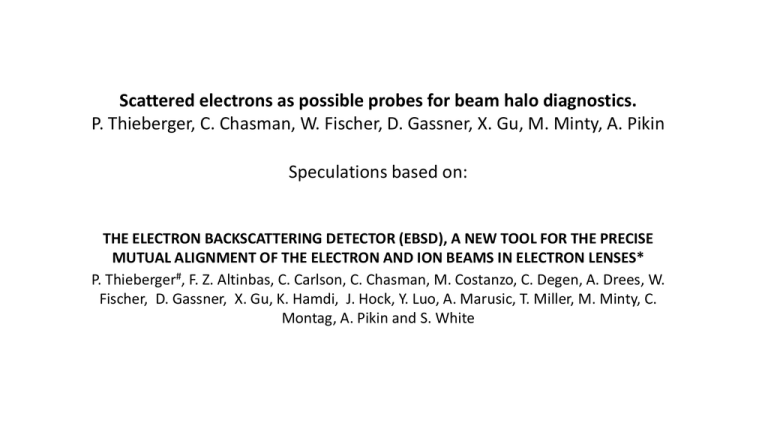
Scattered electrons as possible probes for beam halo diagnostics. P. Thieberger, C. Chasman, W. Fischer, D. Gassner, X. Gu, M. Minty, A. Pikin Speculations based on: THE ELECTRON BACKSCATTERING DETECTOR (EBSD), A NEW TOOL FOR THE PRECISE MUTUAL ALIGNMENT OF THE ELECTRON AND ION BEAMS IN ELECTRON LENSES* P. Thieberger#, F. Z. Altinbas, C. Carlson, C. Chasman, M. Costanzo, C. Degen, A. Drees, W. Fischer, D. Gassner, X. Gu, K. Hamdi, J. Hock, Y. Luo, A. Marusic, T. Miller, M. Minty, C. Montag, A. Pikin and S. White OUTLINE Planned use of backscattered electrons for aligning the electron beams with the proton beams in the RHIC electron lenses. The recent successful commissioning of the electron backscattering detectors (eBSDs) with gold and 3He beams in RHIC. Speculations about possible applications to halo monitoring using hollow electron beams. Other possibilities. Conclusions. RHIC e-lens showing the location of the electron back-scattering detector (eBSD) 3 The beam-beam effect limiting RHIC luminosity will be mitigated with two electron lenses The 2 m long electron and proton beams propagating in opposite direction in two ~6T solenoids have a width of ~300 m rms. The misalignment must be < 30 m for the lenses to work properly. Misaligned can do more harm than good. BPMs are not quite good enough to guarantee satisfactory alignment. We will use electrons backscattered by the protons as the “luminosity signal to achieve alignment The system was recently successfully commissioned with 100 GeV/amu Au and 3He beams Schematic of the detector and of the electron trajectories The electrons, scattered in small impact parameter collisions with the ions, reach the detector located close to the gun after traversing a thin vacuum window ~1 to ~20 MeV The upward trajectory drift is due to the horizontal bend. ION BEAM (~5 keV) End of ~2 m long, 6 T solenoid 4 5 keV electron beam envelope Schematic diagram of the installed hardware 5 Cutaway view of the eBSD insertable housing . 6 Coulomb scattering calculations Small deflections in the ion frame leads to large deflections in the lab. 7 The classical Rutherford scattering equation with quantum and recoil corrections is used to calculate the cross sections s in the ion frame of reference. Transformation to the lab. frame yields the results shown next. Radiative corrections have not been included but may be small – to be verified. 5 keV electrons in axial fields, back-scattered by high energy protons. The curves shown were calculated using 250 GeV protons but the results are almost independent of this energy. Radiative corrections are not included but may perhaps be small (see next slide) Electron-gold eBSD “luminosity” scans obtained by steering the electron beam Date: 4/15/2014 Ion Beam: Gold Beam energy: 100 GeV/u Bunch intensity: 7*108 # of bunches: 2 Solenoid Field: 2T Electron energy: 6 keV e-beam current: 0.565 A The electron beam is steered while the ion beam is stationary. 9 These widths reflect the widths of the electron and the ion beam added in quadrature. The electron beam width is known so the ion beam width can be measured. Electron-gold eBSD horizontal and vertical “luminosity” scans obtained by steering the 100 GeV/amu gold beam These scans are done with an automated optimization program developed for the RHIC experiments. This system will be used here too. eBSD counting-rate as function of detector position obtained with a 100 GeV/amu 3He beam 3He energy: 100 GeV/u # of 3He bunches : 93 Bunch intensity: 4.7E10 e- beam energy: 6 keV e-beam current: 88 mA The counting rates with protons will be similar Time-resolved eBSD counts Ion Beam: Gold Beam energy: GeV/u 100 Bunch intensity: 1.1*109 # of bunches: 2 Electron energy: 5 keV e-beam current: 0.15 A Electron beam OFF Electron beam ON The background is due to electrons from the residual gas ( ~~ 5E-10 Torr at pump ) Here the signal to background ratio was ~20 in spite of the low e-beam current and passible misalignment. Several orders of magnitude can be gained as discussed next. Hollow electron beams as possible halo probes A current density of 1 A/mm2 of 5 keV electrons has an electron density equal to the electron density in 2.15×10-6 Torr of H2 . (useful for rough background estimates). A hollow electron beam seems ideal as a halo probe. But: Some residual gas electrons backscattered by the intense ion beam core will be counted too. Countermeasures: Improve the vacuum. The best way to improve the vacuum would be to use a cold-bore solenoid. Pulse the electron beam Cartoons of possible hollow beam configurations A coaxial design seems attractive but the gun may be difficult to implement. The more conventional design would have a significant background contribution from the beam crossing. Halo detection efficiency would be azimuthally asymmetric. Possible compromise solution An annular electron collector surrounding the ion beam shouldn’t be difficult to design. There is no background-producing beam crossing. The halo detection efficiency can be made azimuthally symmetric Rough order-of-magnitude sensitivity limit A current density of 1 A/mm2 of 5 keV electrons has an electron density equal to the electron density in 2.15×10-6 Torr of H2 . Assumption 1: The cross sectional areas of the ion beam and of the electron annular beam are roughly equal. Assumption 2: We can generate a 5 keV electron annular beam with a current density of 2 A / mm2 Assumption 3: The scattering cross section for the gas electrons is roughly the same as for the electron beam electrons. Assumption 4: We can reach a cryogenic vacuum of 5×10-12 Torr Then a signal-to-background ratio of 1 is reached when the halo is ½ × 5 × 10-12/2.15 × 10-6 = 1.2 × 10-6 of the total ion intensity. Modulating the electron intensity can then be used to correct for the background. Idea for a possible Coulomb Scattering Electron Wire (CSEW) beam profile monitor A ribbon shaped magnetized electron beam intersects the ion beam. Some of the scattered electrons trajectories are intercepted by the detector. The ribbon is steered to map the ion to measure the profile of the ion beam, perhaps including the halo The three sets of solenoids form a closed ion orbit bump. SUMMARY Scattered electrons are good probes for electron lens alignment. Hollow electron beam “lenses” may benefit from the same technique for alignment. Hollow electron beams equipped with eBSDs could become good halo intensity monitors for relativistic ion beams. To obtain maximum sensitivity for very low intensity halos, the vacuum needs to be excellent. Cold-bore solenoids should probably be used. Electron intensity modulation can be used to separate the signal from the background. CORONAGRAPH FOR LHC? NO SHOWSTOPPERS (SO FAR)


